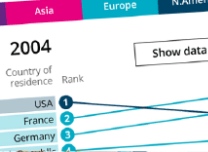Economy Business investment in the UK, provisional: Jan to Mar 2017
Gross fixed capital formation (GFCF), in volume terms, was estimated to have increased by 1.2% to £79.0 billion in Quarter 1 (Jan to Mar) 2017 from £78.1 billion in Quarter 4 (Oct to Dec) 2016.
Business investment was estimated to have increased by 0.6%, to £43.8 billion between Quarter 4 2016 and Quarter 1 2017.
Monthly economic commentary: May 2017
The latest estimate of gross domestic product (GDP) suggests that the economy grew by 0.2% in Quarter 1 (Jan to Mar) 2017 compared with growth of 0.7% in Quarter 4 (Oct to Dec) 2016.
Services output grew by 0.2% in Quarter 1 2017, a slower rate than the average of 0.7% seen over the preceding 16 quarters.
Total production output saw positive growth of 0.1% in Quarter 1 2017 – monthly declines across the quarter were not sufficient to take the average for Quarter 1 2017 below average Quarter 4 2016 levels.
UK GDP, second estimate: Jan to Mar 2017
UK GDP growth in Quarter 1 2017 has been revised down by 0.1 percentage points from the preliminary estimate published on 28 April 2017; mainly due to broad-based downward revisions within the services sector. UK index of services: Mar 2017 Services output increased by 0.2% between February and March 2017.
The largest contribution to the month-on-month growth came from transport, storage and communication, which contributed 0.23 percentage points of which motion pictures contributed 0.16 percentage points. Employment and labour market Young people not in education, employment or training (NEET), UK: May 2017
There were 800,000 young people (aged 16 to 24) in the UK who were not in education, employment or training (NEET), a decrease of 28,000 from October to December 2016 and down 68,000 from a year earlier.
The percentage of all young people in the UK who were NEET was 11.2%, down 0.4 percentage points from October to December 2016 and down 0.8 percentage points from a year earlier. People, population and community Migration in the UK: May 2017
Net long-term international migration was estimated to be +248,000 in 2016, down 84,000 from 2015 (statistically significant); immigration was estimated to be 588,000 and emigration 339,000.
The net migration change was driven by a statistically significant increase in emigration up 40,000 from 2015, mainly EU citizens (117,000, up 31,000 from 2015) and a decrease of 43,000 in immigration (not statistically significant).
EU8 citizens have partly driven the changes with a fall in immigration (down 25,000) to 48,000 and a rise in emigration (up 16,000) to 43,000 in 2016 (both statistically significant changes); this resulted in the smallest net migration estimate (+5,000) for the EU8 since joining the EU in 2004. International migration and the changing nature of housing in England – what does the available evidence show?
Housing demand is influenced by a number of complex factors, including population size, household structure, age of residents and the condition of the economy, as this affects employment, interest rates and other market incentives.
England's resident population increased by 11% between 2001 and 2015, from 49.4 million to 54.8 million; the scale and nature of this growth has varied by region.
Alongside an increase in population, there has also been a 2% increase in the number of households between 2011 and 2015, to 21.9 million households in England.
Short-Term International Migration for England and Wales: year ending June 2015
There are three measures of short-term migration - those that migrate between 1 to 12 months for all reasons, 3 to 12 months for all reasons and the United Nations (UN) definition of those that migrate for 3 to 12 months for work and study; all estimates in this report are for short-term international migration to and from England and Wales.
In year ending (YE) June 2015, short-term immigration for 3 to 12 months for all reasons stood at 304,000 – of these, 39% (118,000) were for the reason "other" (which includes holidays and travelling; visiting or accompanying family and friends; and working holidays); short-term emigration of 3 to 12 months for all reasons was 390,000. | 









No comments:
Post a Comment